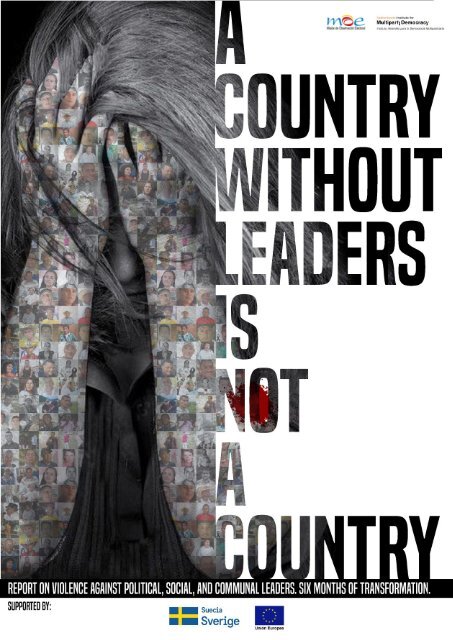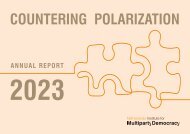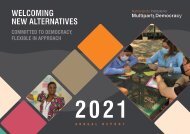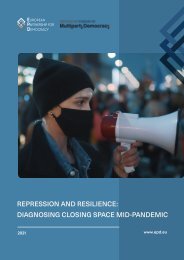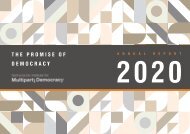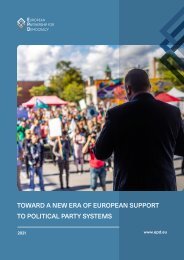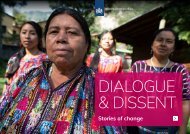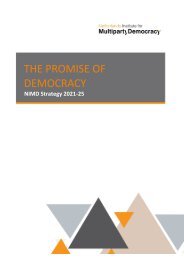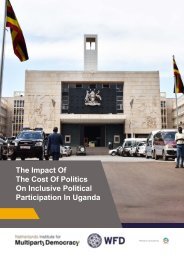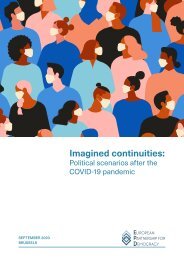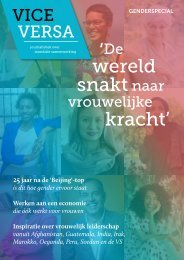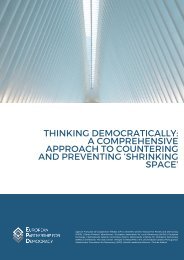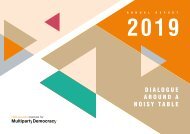Executive summary: A Country without Leaders is not a Country
You also want an ePaper? Increase the reach of your titles
YUMPU automatically turns print PDFs into web optimized ePapers that Google loves.
Alejandra Barrios Cabrera<br />
<strong>Executive</strong> Director<br />
M<strong>is</strong>ión de Observación<br />
Electoral-MOE<br />
Pamela San Martín Ríos y<br />
Valles<br />
Former Counselor of the<br />
Electoral National Institute of<br />
Mexico<br />
Report Coordinator<br />
Germán Andrés Robayo<br />
Cabrera<br />
Subcoordinator of the Political<br />
and Electoral Observatory for<br />
Democracy<br />
M<strong>is</strong>ión de Observación<br />
Electoral-MOE<br />
Senior Researcher<br />
Diego Alejandro Rubiano<br />
Researcher of the Political<br />
and Electoral Observatory for<br />
Democracy<br />
M<strong>is</strong>ión de Observación<br />
Electoral-MOE<br />
Main Researcher<br />
Ángela María Gómez Vega<br />
Researcher of the Political<br />
and Electoral Observatory for<br />
Democracy<br />
M<strong>is</strong>ión de Observación<br />
Electoral-MOE<br />
Research Ass<strong>is</strong>tant<br />
Juan Pablo Ossa Parra<br />
Translator<br />
Editorial Coordination<br />
Jorge Muñoz Cepeda<br />
Chief Editor<br />
Sara Fajardo<br />
Editorial ass<strong>is</strong>tant<br />
Jorge Baquen<br />
Illustration<br />
Rafaela Forero<br />
Design<br />
Con el apoyo de<br />
Th<strong>is</strong> publication was produced with the financial support of the European<br />
Union. Its contents are the sole responsibility of M<strong>is</strong>ión de Observación<br />
Electoral (MOE) and The Netherlands Institute for Multiparty Democracy<br />
(NIMD) and do <strong>not</strong> necessarily reflect the views of the European Union
Picture by: latina.com.ar<br />
Presentation<br />
In the first six months of 2020, the<br />
health emergency experienced<br />
by Colombia, and the entire<br />
world, has transformed political<br />
participation in different ways<br />
and to different degrees. The<br />
situation has forced all actors<br />
in society, particularly those<br />
who seek to influence public<br />
life and political dec<strong>is</strong>ionmaking,<br />
to modify their<br />
actions and strategies in the<br />
face of a new, ever changing<br />
reality, whose final effects<br />
are still unknown. Without<br />
eschewing social d<strong>is</strong>tancing,<br />
new mechan<strong>is</strong>ms have had<br />
to be dev<strong>is</strong>ed to guarantee<br />
checks and balances. It was<br />
necessary to create new<br />
forms of generating an impact<br />
from within communities<br />
while, at the same time, social<br />
problems have become more<br />
pressing but are hidden from<br />
sight due to the unprecedent<br />
health and economic cr<strong>is</strong>es.<br />
In Colombia, for instance, the<br />
election of Communal Action<br />
Boards (JAC )¹ –one of the first<br />
building blocks of democracywas<br />
postponed <strong>without</strong> a clear<br />
route to guarantee citizen<br />
participation at the most local<br />
level.<br />
Th<strong>is</strong> scenario <strong>is</strong> taking place in<br />
a post-conflict period, after the<br />
signing of the Peace Agreement<br />
1. Acronyms in the document refer to the initials in Span<strong>is</strong>h.<br />
in 2016. Though th<strong>is</strong> event<br />
opened a window of opportunity<br />
to put an end to violence,<br />
th<strong>is</strong> objective seems more<br />
d<strong>is</strong>tant every day. The violence,<br />
particularly that exerc<strong>is</strong>ed<br />
against leaders, <strong>is</strong> explained<br />
<strong>not</strong> only by the h<strong>is</strong>torical<br />
conflict against different Illegal<br />
Armed Groups (GAIs), but by<br />
the sum of multiple factors<br />
and structural causes, of weak<br />
institutions unable to face the<br />
diverse, local, regional, and<br />
national interests that seek<br />
to attack various leaders in<br />
order to seize or perpetuate<br />
power. Despite the multicausal<br />
origins of violence, in the<br />
public d<strong>is</strong>course, it seems that<br />
all the violence <strong>is</strong> originated<br />
by the armed conflict, which<br />
simultaneously explains and<br />
conceals everything.<br />
Thus, given its constant<br />
monitoring of violence<br />
against political, social,<br />
and communal leaders, the<br />
Electoral Observation M<strong>is</strong>sion<br />
-MOE Colombia- presents th<strong>is</strong><br />
report on the security situation<br />
during the first semester<br />
of th<strong>is</strong> convulsed 2020. The<br />
report warns that the course<br />
of the year has been marked<br />
by serious aggressions against<br />
social leaders who have<br />
suffered the highest levels of<br />
an increasingly lethal violence.<br />
The numbers reg<strong>is</strong>tered during<br />
the most restrictive period of<br />
social d<strong>is</strong>tancing and lockdowns<br />
show a general decline in acts<br />
of violence against leaders and<br />
military actions from illegal<br />
armed groups. However, in<br />
Colombia, even under extreme<br />
sanitary measures, attacks<br />
against civilians in general<br />
and local leaders in particular<br />
<strong>is</strong> a phenomenon that has <strong>not</strong><br />
ceased.<br />
Because violence against<br />
leaders has <strong>not</strong> let up, with th<strong>is</strong><br />
report, MOE seeks to highlight<br />
<strong>not</strong> only the figures of what<br />
has happened throughout the<br />
first half of the year, but also<br />
the impact that acts of violence<br />
have on victims and, in the<br />
case of social leaders, on their<br />
communities.<br />
The importance of th<strong>is</strong> report<br />
<strong>is</strong> that to bear witness to an<br />
increase in the number of<br />
aggressions against social<br />
leaders, as evidence shows,<br />
<strong>is</strong> to reveal the intent to attack<br />
the processes that underpin<br />
citizenship itself. Violence <strong>is</strong><br />
becoming more lethal, which<br />
<strong>is</strong> evidence that social causes<br />
that are <strong>not</strong> stopped by threats<br />
are then attacked with violence<br />
to silence voices.<br />
And these are <strong>not</strong> just any<br />
voices. These are the voices<br />
that represent the effort of<br />
citizens to remedy the gaps left<br />
by the State itself. These are<br />
voices that seek to transform<br />
their surroundings, they are<br />
the voices of peasant activ<strong>is</strong>m,<br />
women movements, indigenous<br />
communities and communities<br />
of African descent, they are<br />
victims of human rights abuses,<br />
and the LGBTIQ community,<br />
they are activ<strong>is</strong>ts for land, the<br />
environment, and those who<br />
seek a more equal country.<br />
Violent acts committed against<br />
them <strong>not</strong> only put a stop to the<br />
important work of leaders, but<br />
it has the additional effect of<br />
stunting those who work for<br />
the same causes; those who,<br />
although they will continue<br />
their work, will now do so with<br />
fear.<br />
Year after year, the figures<br />
of leaders who are attacked,<br />
threatened, kidnapped,<br />
d<strong>is</strong>appeared, are victims of<br />
assassination attempts, and<br />
those who are indeed murdered<br />
are revealed. In many ways th<strong>is</strong><br />
violence has been normalized<br />
by society. To a large extent<br />
it has been explained as a<br />
consequence of the “conflict”.<br />
Nevertheless, when th<strong>is</strong><br />
violence <strong>is</strong> understood solely in<br />
light of the conflict, the victims<br />
are set aside and turned into<br />
stat<strong>is</strong>tical data. But we must<br />
recognize that they are <strong>not</strong><br />
numbers. They are persons,<br />
leaders whose work must<br />
be pra<strong>is</strong>ed, for the violence<br />
they suffer d<strong>is</strong>rupts the<br />
communities and the country’s<br />
political life. These aggressions<br />
have serious repercussions in<br />
the security of all those who<br />
work to make Colombia a<br />
different country.<br />
The figures in th<strong>is</strong> report show<br />
that violence <strong>not</strong> only pers<strong>is</strong>ts,<br />
but that it has reached new<br />
territories and intensified in<br />
those where the conflict has<br />
a h<strong>is</strong>torical presence. Th<strong>is</strong> <strong>is</strong><br />
particularly true in regions<br />
prioritized by the State where,
despite the implementation of Development Plans with Territorial<br />
Scope (PDETS), the State’s pers<strong>is</strong>tent absence has meant that<br />
prevention and protection measures are clearly insufficient.<br />
Likew<strong>is</strong>e, the document reveals how political leaders were the<br />
target of attacks, during the first semester of 2020. Particularly,<br />
at regional and local levels, violence against elected officials has<br />
increased. Just after six months in office, mayors and councilmen<br />
mainly, have experienced continuous aggressions. Th<strong>is</strong> <strong>is</strong> proof of<br />
the intention of those exerc<strong>is</strong>ing violence to control <strong>not</strong> only social<br />
activity, but the State itself, by subjugating its leaders through fear.<br />
If the levels of lethality of these actions increase, the situation<br />
could result in atypical elections, such as those that occurred in<br />
the municipality of Sutatausa, Cundinamarca.<br />
Communal leaders have also<br />
been affected by violence during<br />
th<strong>is</strong> semester, prominently<br />
JAC’s presidents. In th<strong>is</strong> regard,<br />
MOE Colombia has identified<br />
that the more localized leaders<br />
are exposed <strong>not</strong> only to greater<br />
amounts of violence, but also to<br />
more deadly forms. Th<strong>is</strong> <strong>is</strong> the<br />
case of communal as well as of<br />
many social leaders who are<br />
exposed to different r<strong>is</strong>ks as a<br />
consequence of acting in rural<br />
areas where armed groups and<br />
illegal economies are present.<br />
The report presents detailed<br />
data and analyses of the<br />
security situation of different<br />
leaders. Given th<strong>is</strong> situation,<br />
it <strong>is</strong> <strong>not</strong> feasible to separate<br />
the study of Illegal Armed<br />
Groups from their behavior and<br />
presence in a territory. Although<br />
they are <strong>not</strong> solely responsible<br />
for the aggressions, there <strong>is</strong><br />
a clear correlation between<br />
the counties with the highest<br />
number of violent events<br />
against leaders and the<br />
presence of armed actors.<br />
Due to th<strong>is</strong> setting, and based<br />
on the evidence of protection<br />
policies that, despite their<br />
progress have been clearly<br />
insufficient, th<strong>is</strong> report<br />
includes a chapter with a<br />
concrete strategy to enhance<br />
public policies to prevent and<br />
protect social and communal<br />
leaders and those working<br />
in the defense of human<br />
rights. Th<strong>is</strong> section proposes<br />
integral mechan<strong>is</strong>ms that are<br />
adaptable to each specific<br />
context and that can be easily<br />
applied by authorities. These<br />
mechan<strong>is</strong>ms entail a minimum<br />
impact on current budgets and<br />
the f<strong>is</strong>cal rule as it <strong>is</strong> conscious<br />
of the sanitary and economic<br />
emergency and its demand<br />
for resources <strong>not</strong> previously<br />
assigned.<br />
Finally, th<strong>is</strong> document will<br />
briefly expose concrete<br />
recommendations that can be<br />
applied by authorities at all<br />
levels, in order to guarantee<br />
the protection of the different<br />
types of leadership.<br />
In order to advance towards<br />
peace, one of the greatest<br />
challenges that the country<br />
faces <strong>is</strong> ensuring that violence<br />
<strong>is</strong> <strong>not</strong> normalized. Voices must<br />
be ra<strong>is</strong>ed, indignation must<br />
ar<strong>is</strong>e in the face of attacks<br />
against leaders, and demands<br />
must be made <strong>not</strong> only to the<br />
Government, but to the State as<br />
a whole for the establ<strong>is</strong>hment<br />
of effective mechan<strong>is</strong>ms to<br />
prevent and protect the life<br />
and integrity of the different<br />
people that work through their<br />
leadership for citizens, for their<br />
rights, and in order to make<br />
Colombia a better country.<br />
PAMELA SAN MARTÍN RÍOS Y VALLES<br />
Ex Consejera del Instituto Nacional Electoral –INE– de México
<strong>Executive</strong><br />
Summary<br />
81 assassinations<br />
have been<br />
committed so far<br />
in 2020.<br />
In the course of the first<br />
semester of 2020 (January<br />
1st to June 30th), 248 events<br />
of violence against political,<br />
social, and communal leaders<br />
were reg<strong>is</strong>tered by MOE. A<br />
2% decline occurred when<br />
compared with the same<br />
period of 2019, when 253<br />
violent acts were reported.<br />
Nevertheless, these figures<br />
are worrying as they show<br />
that violence has <strong>not</strong> ceased,<br />
nor has it been substantially<br />
reduced. The above data <strong>is</strong><br />
even more serious when<br />
considering that there was an<br />
important reduction in violent<br />
acts during the month and a<br />
half that strict confinement<br />
measures were decreed by the<br />
national government (equal<br />
to 25% of the semester). The<br />
reduction in violence during<br />
the strictest lockdown, did <strong>not</strong><br />
offset the overall incidence of<br />
violence for the entire period.<br />
On average, 1.6 events of<br />
violence were reg<strong>is</strong>tered<br />
per day during the periods<br />
<strong>without</strong> strict confinement.<br />
Conversely, in periods of severe<br />
restrictions, these acts were<br />
reduced by 50% to an average<br />
of 0.8 each day.<br />
Regarding lethal violence,<br />
81 assassinations have been<br />
committed so far in 2020, June<br />
being the most violent month<br />
with 20 events. Th<strong>is</strong> figure<br />
represents an 82 percent<br />
increase when compared<br />
to May 2020. If the overall<br />
lethality <strong>is</strong> compared with the<br />
same period in 2019, when 61<br />
murders were reported, the<br />
increase <strong>is</strong> of 32.7%.<br />
During th<strong>is</strong> first semester of<br />
2020, violence perpetrated<br />
against social, political, and<br />
communal leaders has spread<br />
steadily throughout the national<br />
territory. Keeping the same<br />
trend of the previous 4 years,<br />
the departments of Cauca,<br />
Arauca, Norte de Santander,<br />
Antioquia, and Córdoba account<br />
for nearly half of the acts of<br />
violence that took place in the<br />
country during the first half of<br />
the present year.<br />
52 of the 81 killings of leaders<br />
committed in Colombia during<br />
these six months happened<br />
in PDET territories - regions<br />
where the Plans of Development<br />
with a Territorial Focus were<br />
carried out. Th<strong>is</strong> means that<br />
64.2% of the murders occurred<br />
in zones that were prioritized by<br />
the State to prevent hotspots of<br />
violence. Th<strong>is</strong> represents a 39%<br />
increase over 2019, when 39<br />
assassinations were reported.<br />
Regarding each particular<br />
type of leadership, social<br />
leaders have suffered the<br />
greatest amount of violations,<br />
concentrating 50% of the<br />
Arauca, Norte de Santander,<br />
Antioquia, and Córdoba account<br />
for nearly half of the acts of<br />
violence that took place in the<br />
country.
Social leaders have suffered<br />
the greatest amount of<br />
violations, concentrating<br />
50% of the attacks. In<br />
other words, for every two<br />
leaders attacked in Colombia<br />
one <strong>is</strong> a social leader.<br />
attacks. In other words, in the<br />
six months covered by th<strong>is</strong><br />
report, for every two leaders<br />
attacked in Colombia one <strong>is</strong> a<br />
social leader. Though acts of<br />
violence against social leaders<br />
have been increasing year after<br />
year, the first semester of 2020<br />
stands out for the lethality of the<br />
aggressions, even in the period<br />
of strict confinement. The<br />
number of killings increased<br />
by 85% (going from 28 murders<br />
in 2019 to 52 in 2020), while<br />
threats decreased 24%.<br />
When the ethnic component<br />
of the effects on th<strong>is</strong> type<br />
of leadership <strong>is</strong> reviewed, it<br />
turns out that 58% of violent<br />
events against afro Colombian<br />
leaders were lethal (of the<br />
12 acts of violence recorded,<br />
5 were killings and 2 were<br />
assassination attempts). In the<br />
case of indigenous leaders, the<br />
lethality reached 70% of the 20<br />
events reported (13 killings and<br />
1 assassination attempt).<br />
The departments of Cauca,<br />
Chocó, and Valle de Cauca<br />
concentrate 54.8% of the total<br />
aggressions against afro<br />
and indigenous leaders in<br />
Colombia. The department of<br />
Cauca merits special attention<br />
since 7 of the 9 indigenous<br />
leaders that suffered attacks<br />
were murdered.<br />
Regarding the geographical<br />
location of lethal violence<br />
against social leaders, there<br />
<strong>is</strong> an alarming situation in the<br />
departments of Cauca, that had<br />
a 250% increase in the number<br />
of killings reported (6 in 2019,<br />
against 21 in 2020); Córdoba<br />
with a 400% increase (1 killing<br />
in 2019, against 5 in 2020);<br />
Bolívar with an increase of<br />
150% (2 killings in 2019, against<br />
5 in 2020); Putumayo with a<br />
percentage variation of 200%<br />
(1 killing in 2019, against 3 in<br />
2020); North Santander which<br />
has maintained a relatively<br />
constant number of killings<br />
in both periods, with a 33%<br />
increase (3 killings in 2019,<br />
against 4 in 2020).<br />
70 of the 124 acts of violence<br />
against social leaders (56% of<br />
them) occurred in 13 of the 16<br />
PDET territories (81% of the<br />
zones). In these regions the<br />
assassination of social leaders<br />
has increased by 74% (going<br />
from 19 killings in 2019 to 33 in<br />
2020).<br />
The worsening of lethal<br />
violence against social leaders<br />
in the PDET regions stands out<br />
in Nariño-Cauca and south<br />
Córdoba. In 2019, Nariño-Cauca<br />
reg<strong>is</strong>tered 6 murders, while 14<br />
have been perpetrated in 2020<br />
(representing a 133% increase).<br />
In south Córdoba, killings went<br />
from 2 in 2019 to 7 in 2020 (a<br />
250% increase).<br />
Political leaders are the<br />
second most affected type of<br />
leadership, with 89 violent<br />
acts during the first 6 months<br />
of 2020 (39.5% of the acts of<br />
violence in the country). Of the<br />
total number of aggressions,<br />
73 where threats, which<br />
amounts to 82% of the cases.<br />
In relation to the lethality of the<br />
violent acts against political<br />
leaders, 2020 has experienced<br />
a 45% decrease in compar<strong>is</strong>on<br />
to 2019, which was an electoral<br />
year.<br />
Throughout the period analyzed,<br />
the acts of violence directed at<br />
elected officials <strong>is</strong> <strong>not</strong>eworthy.<br />
They account for 60.7% of the<br />
aggressions against political<br />
leaders and represent a 35%<br />
increase compared to the<br />
previous year. While in 2019, 40<br />
elected officials were affected,<br />
54 were so in the first six<br />
months of 2020.<br />
Th<strong>is</strong> year, 60% of the<br />
killings of political leaders<br />
are concentrated in the<br />
departments of Antioquia<br />
(2), Valle del Cauca (2), and<br />
Córdoba (2). The events in the<br />
department of Vichada draw<br />
attention because it had <strong>not</strong><br />
reg<strong>is</strong>tered any violent act<br />
against leaders in the previous<br />
4 years. However, Olga<br />
Lucia Hernández, a former<br />
candidate for the Liberal Party<br />
to the municipal council of<br />
Cumaribo for the Liberal Party,<br />
was murdered in May 2020.<br />
Likew<strong>is</strong>e, the situation in the<br />
department of Sucre ra<strong>is</strong>es<br />
particular concern. While in<br />
2019 there were no records<br />
of assassination attempts or<br />
homicides, one of each type of<br />
these acts has been reg<strong>is</strong>tered<br />
so far in 2020.<br />
With respect to communal<br />
leaders, 35 acts of violence<br />
have been perpetrated against<br />
them in 2020, representing a<br />
13% increase in relation to the 31<br />
events reg<strong>is</strong>tered in the same
period of 2019. It’s important<br />
to underscore that 60% of the<br />
attacks were lethal (killings<br />
or assassination attempts),<br />
placing these leaders in a<br />
particular situation of r<strong>is</strong>k,<br />
especially the Presidents of<br />
Communal Action Boards<br />
(JAC). While 18 of them were<br />
victims of some act of violence,<br />
9 of them (50%) were killed.<br />
Antioquia <strong>is</strong> the department<br />
that ra<strong>is</strong>es the most concern,<br />
since 6 communal leaders<br />
have been killed, 4 of them in<br />
the region of Bajo Cauca. Th<strong>is</strong><br />
represents a 300% increase<br />
in murders compared to the<br />
previous year (1 killing in 2019<br />
versus 4 in 2020). The situation<br />
in the department of Putumayo<br />
also stands out, particularly<br />
in the municipality of Puerto<br />
Guzmán, where 3 former<br />
members and members of JAC<br />
were killed.<br />
Of the 35 acts of violence<br />
against communal leaders,<br />
24 (68.6%) were perpetrated<br />
in PDET territories. Of these,<br />
62.5% (15 events) were killings.<br />
Compared to the previous<br />
year, the region of Bajo Cauca<br />
stands out, as it maintains<br />
the pattern of lethal violence<br />
against th<strong>is</strong> class of leaders<br />
(4 assassinations). Likew<strong>is</strong>e,<br />
despite <strong>not</strong> reg<strong>is</strong>tering violent<br />
acts against communal leaders<br />
during the first six months of<br />
2019, Catatumbo and Putumayo<br />
experienced 3 killings in 2020.<br />
In the case of both communal<br />
and social leaders, 46% of the<br />
events occurred in the rural<br />
sectors of the municipalities,<br />
where they are more exposed<br />
to the diverse r<strong>is</strong>ks posed by<br />
the presence of armed groups<br />
and illegal economies.<br />
With regard to the acts of<br />
violence against women<br />
who are political, social and<br />
communal leaders, during the<br />
first six months of each year,<br />
from 2016 to 2020 a constant<br />
growth in the number of<br />
aggressions against them <strong>is</strong><br />
<strong>not</strong>iced. They went form 17<br />
women leaders attacked in<br />
2016, to 20 in 2017, 29 in 2018,<br />
and 57 in 2020. These figures<br />
are worr<strong>is</strong>ome because<br />
despite the overall reduction<br />
of violence during the first six<br />
months of 2020, aggressions<br />
against women leaders<br />
increased by 18.8% compared<br />
to the same period in 2019.<br />
Threats are the most recurrent<br />
act of violence against women<br />
in a position of leadership.<br />
Nevertheless, it´s important to<br />
acknowledge that in the case of<br />
women these aggressions have<br />
a particular character<strong>is</strong>tic.<br />
By exerting th<strong>is</strong> mechan<strong>is</strong>m<br />
In the case of both communal<br />
and social leaders, 46% of the<br />
events occurred in the rural<br />
sectors of the municipalities.<br />
Picture by:<br />
Fundación, paz y reconciliación<br />
of pressure on them, the<br />
perpetrators also resort to<br />
stereotypes and symbol<strong>is</strong>ms<br />
that extend the impact to their<br />
families and close ones, thus<br />
affecting the psychological<br />
integrity of those around them.<br />
That said, of the 109<br />
municipalities where violence<br />
against political, social, and<br />
communal leaders has been<br />
reported in the course of 2020,<br />
67% of them (73 municipalities)<br />
have the presence of at least<br />
one illegal armed group.<br />
Additionally, 75.2% of lethal<br />
acts against leaders were<br />
perpetrated in municipalities<br />
where the presence of such<br />
groups <strong>is</strong> reg<strong>is</strong>tered. However,<br />
it can<strong>not</strong> be inferred that all<br />
violent acts against leaders<br />
that occur in these territories<br />
can be attributed to armed<br />
groups. In fact, a relevant<br />
number of violent and lethal<br />
acts have been reg<strong>is</strong>tered in<br />
territories with no presence of<br />
Illegal Armed Groups.<br />
In th<strong>is</strong> regard, the progress<br />
in investigations on cases<br />
of violence against social,<br />
political, and communal leaders<br />
reinforces the hypothes<strong>is</strong> that<br />
the various interests at the<br />
local level behind the violence<br />
against leaders are <strong>not</strong> always<br />
related to armed groups.<br />
For th<strong>is</strong> reason, MOE has<br />
ins<strong>is</strong>ted on the need to<br />
identify the legal and illegal<br />
actors behind the planning<br />
and execution of these acts,<br />
and to establ<strong>is</strong>h effective<br />
mechan<strong>is</strong>ms to prevent and<br />
protect the life and integrity of<br />
those who exerc<strong>is</strong>e leadership<br />
in the country.<br />
In relation to the belligerent<br />
actions of Illegal Armed Groups<br />
-GAI-, during the first semester<br />
of 2020, a 6% decline in the<br />
number of violent acts was<br />
experienced, compared with<br />
the same period of 2020. In 2019,<br />
260 violent actions occurred,<br />
in contrast to 245 in 2020.<br />
Nevertheless, th<strong>is</strong> reduction<br />
can<strong>not</strong> be understood as a deescalation<br />
of armed actions.<br />
Likew<strong>is</strong>e, during the first<br />
semester of th<strong>is</strong> year, the<br />
overall intensity of the conflict<br />
has remained constant, despite<br />
the consequences of the health<br />
emergency in some regions<br />
with presence of GAI.<br />
Thus, according to the data,<br />
during the pandemic, illegal<br />
armed groups continued to<br />
operate, despite the unilateral<br />
ceasefire decreed by ELN in<br />
April 2020.<br />
Regarding the intimidations<br />
committed by GAI, a 13%<br />
decrease was experienced<br />
during the first semester of<br />
2020, compared to the same<br />
period of 2019. 92 intimidations<br />
occurred in 2019 compared to<br />
80 recorded in 2020. These were<br />
mainly linked to the quarantine<br />
and the humanitarian cr<strong>is</strong><strong>is</strong>,<br />
as the ELN, FARC d<strong>is</strong>sidents,<br />
and Organized Armed Groups<br />
-GAO- resorted to armed<br />
“deterrence” to force the<br />
confinement of the population.<br />
Th<strong>is</strong> was particularly evident<br />
in the departments of<br />
Nariño, Antioquia, Cauca, and<br />
Putumayo.<br />
Since the beginning of que<br />
quarantine, the decline in violent<br />
actions against leaders in those<br />
territories that coincide with<br />
the presence of armed groups<br />
interested in affecting the<br />
different types of leaderships<br />
<strong>is</strong> a phenomenon that merits<br />
attention. Nevertheless, during<br />
th<strong>is</strong> same period, the GAIs<br />
expanded and exerc<strong>is</strong>ed a more
effective control in a larger<br />
number of municipalities. Th<strong>is</strong><br />
can be corroborated by the fact<br />
that within the more restrictive<br />
period of confinement, the<br />
number of regions with an<br />
IAG presence increased in 31<br />
municipalities.<br />
With respect to the ELN,<br />
the group carried out 101<br />
violent actions during the<br />
first semester of 2020 which<br />
amounts to a 10% increase<br />
compared to its 9 actions in 2019.<br />
During th<strong>is</strong> period, February<br />
was the month with the highest<br />
number of violent actions by<br />
the ELN, prec<strong>is</strong>ely when they<br />
decreed an “armed strike” that<br />
included actions against civil<br />
society and the Public Force<br />
in the departments of Norte<br />
de Santander (Catatumbo<br />
Region), Arauca, Chocó, and<br />
Cesar. Likew<strong>is</strong>e, in May, once<br />
their unilateral ceasefire<br />
ended, there was a significant<br />
increase in the number of<br />
armed actions, a r<strong>is</strong>e of 250%<br />
over April.<br />
MOE calls for peace<br />
negotiations to begin again<br />
between the government and<br />
the ELN. Their presence in at<br />
least 20 departments of the<br />
country, and their capacity to<br />
affect the civilian population,<br />
should be reason enough to<br />
resume dialogues and seek<br />
a bilateral and definitive<br />
ceasefire. However, th<strong>is</strong><br />
must be accompanied by<br />
a commitment on the part<br />
of ELN to stop child forced<br />
recruitment, kidnapping, and<br />
release all those held captive.<br />
Regarding FARC d<strong>is</strong>sidents,<br />
th<strong>is</strong> semester the number of<br />
violent actions declined by 11%<br />
compared to the same period of<br />
2019. Th<strong>is</strong> year they committed<br />
73 actions, in contrast to 82<br />
committed in 2019. These were<br />
concentrated mainly in the<br />
department of Cauca with 40%<br />
of them, followed by Nariño with<br />
12.3%. The most violent month<br />
was March when the mandatory<br />
preventive confinement was<br />
decreed by the government,<br />
and d<strong>is</strong>sidents intimated<br />
civilians under the justification<br />
of enforced confinement. Of<br />
the 22 actions reg<strong>is</strong>tered that<br />
month, 54% of them took place<br />
in Cauca, specifically in the<br />
Picture by: semanarutal.com<br />
north and center regions of the<br />
department.<br />
So far th<strong>is</strong> year, violent<br />
actions by the GAO declined<br />
20%, considering that the<br />
previous year 75 actions where<br />
reg<strong>is</strong>tered, in contrast to the 60<br />
actions reported in 2020. These<br />
actions concentrated in the<br />
departments of Antioquia (31),<br />
Chocó (14), Norte de Santander<br />
(6), Putumayo (3), Córdoba (3),<br />
Nariño (2), and La Guajira (1). In<br />
the northern part of Colombia<br />
towards the end of the first<br />
semester, the tensions between<br />
Los Caparrapos, Autodefensas<br />
Gaitan<strong>is</strong>tas de Colombia -AGC-<br />
, and FARC’s d<strong>is</strong>sidents became<br />
evident. Therefore, it’s a region<br />
were violence could increase if<br />
urgent actions are <strong>not</strong> taken by<br />
authorities.<br />
During the first semester of<br />
2020, just in Antioquia, Choco,<br />
and Córdoba, Autodefensas<br />
Gaitan<strong>is</strong>tas de Colombia -AGCand<br />
Los Caparrapos committed<br />
45 violent actions (which<br />
represent 75% of the actions<br />
committed by these groups).<br />
Massacres that subsequently<br />
caused the d<strong>is</strong>placement of the<br />
civilian population from rural to<br />
urban zones stand out among<br />
these actions.<br />
So far in 2020, 11 violent actions<br />
perpetrated by Los Pelusos<br />
have been reg<strong>is</strong>tered, exactly<br />
the same number of events as<br />
the previous year.<br />
Th<strong>is</strong> report emphasizes the<br />
source of financing of illegal<br />
armed groups, which <strong>is</strong> mainly<br />
linked to drug trafficking. As<br />
such, it was identified that<br />
the GAI pretend to control the<br />
areas that concentrate coca<br />
and marihuana crops. That <strong>is</strong>,<br />
the pacific region of Nariño and<br />
Choco, the center and north of<br />
Cauca, the Catatumbo region in<br />
Norte de Santander, the lower<br />
Cauca in Antioquia, south<br />
Córdoba, the zone between<br />
the departments of Meta and<br />
Guaviare, and the departments<br />
of Putumayo and Caquetá.<br />
Due to the pandemic criminal<br />
groups have been forced to<br />
change some of the ways of<br />
doing business, as they find<br />
themselves in a context in<br />
which supply and transport<br />
chains have been altered, their<br />
income has been reduced due<br />
to lack of available markets,<br />
and an increase in violence<br />
caused by d<strong>is</strong>putes over the<br />
control of the drug business.<br />
Although an analys<strong>is</strong> of the<br />
data shows a general decrease<br />
in the overall number of violent<br />
acts, a different picture <strong>is</strong><br />
revealed when the number of<br />
confrontations between illegal<br />
armed groups <strong>is</strong> considered.<br />
These have increased by 27%.<br />
In light of the political violence<br />
and the analys<strong>is</strong> of GAI<br />
activity, MOE identified some<br />
departments that merit a<br />
detailed analys<strong>is</strong> in order to<br />
understand the specificities<br />
of the phenomenon of<br />
violence. That <strong>is</strong> the case of<br />
the departments of César,<br />
Córdoba, and La Guajira, since<br />
they concentrate 45% of the<br />
events in the Caribbean region.<br />
Likew<strong>is</strong>e, MOE emphasized<br />
the departments of Antioquia,<br />
Cauca, and Norte de Santander<br />
because they are the most<br />
affected territories, both by<br />
violent events against leaders<br />
and by the presence of GAI.<br />
In the case of César, it <strong>is</strong><br />
important to advice about<br />
the increasing lethality in<br />
the events in 2020, since the<br />
proportion of threats versus<br />
killings has turned upside<br />
down in the course of th<strong>is</strong> year,<br />
compared to the previous one.<br />
If th<strong>is</strong> tendency continues,<br />
2020 could record a similar<br />
number of events against<br />
leaders as 2019, but more<br />
lethal. Violent events have<br />
concentrated in the northern<br />
part of the department where<br />
the ELN makes presence as it<br />
<strong>is</strong> a strategic corridor for drug<br />
trafficking.<br />
As for Córdoba, in th<strong>is</strong> region, it<br />
<strong>is</strong> the department with the most<br />
violence against leaders with<br />
15 acts (31% of those reg<strong>is</strong>tered<br />
in the Caribbean region)<br />
during the first semester of<br />
2020. Their lethality stands<br />
out since 7 of them (46.7%)<br />
were assassinations. AGC<br />
and the Los Caparrapos, who<br />
are in confrontation against<br />
each other, are present in<br />
th<strong>is</strong> department. In the midst<br />
of these clashes, the civilian<br />
population and leaders remain<br />
in extreme danger.
In respect to the department<br />
of La Guajira, there <strong>is</strong> a<br />
latent r<strong>is</strong>k to the different<br />
leaderships in the region.<br />
Though no assassinations<br />
were reg<strong>is</strong>tered during the<br />
first 6 months of the year, it´s<br />
worth <strong>not</strong>ing that last year La<br />
Guajira was in third place in<br />
terms of the departments with<br />
more violence (with 41 events,<br />
7 of them lethal). On the other<br />
hand, the analys<strong>is</strong> of political<br />
context <strong>is</strong> particularly relevant<br />
in th<strong>is</strong> department. The political<br />
instability in which it has been<br />
immersed during the last two<br />
constitutional periods, its<br />
condition as a border territory<br />
with Venezuela, and the<br />
confluence of armed groups<br />
with drug trafficking structures<br />
are variables that compel us<br />
to keep a close look on the<br />
situation experienced there,<br />
and the conditions in which<br />
innumerable leaders carry on<br />
their activities.<br />
On the other hand, Cauca <strong>is</strong><br />
Colombia’s department with the<br />
most acts of violence against<br />
political, social, and communal<br />
leaders. From January 1 to<br />
June 30, 2020, 45 violent events<br />
occurred, 18% of those reported<br />
in the country. 57.8% of these<br />
events have been lethal. Social<br />
leaders were victims of 91% of<br />
the assassinations committed<br />
in th<strong>is</strong> department. Indigenous<br />
leaders has been the type of<br />
leadership most victimized.<br />
78% of the indigenous<br />
leaders attacked in 2020<br />
were murdered. Th<strong>is</strong> violence<br />
could be mainly related to the<br />
presence of the ELN and FARC<br />
d<strong>is</strong>sidents, and to a lesser<br />
extent to GAO and EPL seeking<br />
to gain control of illegal crop<br />
production and trade chains.<br />
As for Antioquia, 16 acts of<br />
political, social and communal<br />
violence were reg<strong>is</strong>tered in<br />
11 of its municipalities. It’s<br />
important to underscore that<br />
75% of these events (12) were<br />
lethal. In th<strong>is</strong> regard, 66.7% of<br />
the killings were perpetrated<br />
against communal leaders.<br />
These events occurred mainly<br />
in the Uraba and lower Cauca<br />
sub-regions, where GAO <strong>is</strong><br />
present and coex<strong>is</strong>t with<br />
legal and illegal economies<br />
that struggle for control of<br />
the territory, resources, and<br />
population.<br />
Lastly, until June 30, 2020, 16<br />
acts of violence were reg<strong>is</strong>tered<br />
in Norte de Santander. It’s<br />
<strong>not</strong>eworthy, that 62.5% of these<br />
events were lethal. They were<br />
perpetrated against 5 social<br />
leaders, 3 communal leaders,<br />
and 2 political leaders. Th<strong>is</strong><br />
violence <strong>is</strong> related to the<br />
presence of different GAI such<br />
as the ELN, Los Pelussos-<br />
EPL, and the Rastrojos. The<br />
Catatumbo region <strong>is</strong> strategic<br />
for illegal weapon trade,<br />
migration, smuggling, drug<br />
trafficking, and the transit of<br />
illegal actors to Venezuela,<br />
which makes it a zone of<br />
intense d<strong>is</strong>putes for territorial<br />
control.<br />
In view of the extension of<br />
the violence in Colombia, and<br />
considering the economic<br />
context that has derived<br />
from the health emergency,<br />
it <strong>is</strong> necessary to rethink the<br />
protection mechan<strong>is</strong>ms being<br />
enacted, in order to identify<br />
viable and more effective<br />
alternatives. In th<strong>is</strong> context, it´s<br />
desirable to move towards a<br />
concept of collective protection in addition to the individual one<br />
dominant in current policies. Collective protection mechan<strong>is</strong>ms<br />
could allow a more efficient use of resources and actions<br />
to encompass and address in a better way the phenomena of<br />
violence against leadership that hunts the country.
Recommendations<br />
1In order to address the problem of<br />
violence towards leaders, mainly<br />
against social and communal<br />
leaders, the MOE recommends<br />
that the authorities at different<br />
territorial levels adopt the<br />
necessary measures to protect and<br />
recognize <strong>not</strong> only the actions of<br />
individuals but also the work of the<br />
community in the defense of rights.<br />
The practice of rights protection<br />
should <strong>not</strong> be understood only as<br />
a practice of representation and<br />
the voice of one person but as an<br />
exerc<strong>is</strong>e of the community as a<br />
whole.<br />
3A joint effort between<br />
national and local authorities<br />
<strong>is</strong> necessary to put forward<br />
humanitarian, health, and<br />
justice m<strong>is</strong>sions, and to<br />
provide public services<br />
to remote areas from the<br />
municipal capitals of affected<br />
territories. Th<strong>is</strong> <strong>is</strong> so State presence<br />
<strong>is</strong> <strong>not</strong> exclusively understood as<br />
synonymous with public force<br />
or militarization, but rather that<br />
it expands the supply of public<br />
services in the territory.<br />
2The MOE recommends that<br />
officials in the interior sector<br />
(Min<strong>is</strong>try of the Interior and<br />
Government Min<strong>is</strong>tries) at<br />
different territorial levels<br />
promote network building<br />
at the local, national, and<br />
international level on<br />
leadership practices, to serve as a<br />
comprehensive platform for training,<br />
improvement, and exchange of best<br />
practices among local leaders.<br />
4The MOE recommends<br />
officials in the interior sector<br />
(Min<strong>is</strong>try of the Interior and<br />
Government Min<strong>is</strong>tries) at<br />
different territorial levels<br />
to proceed with training<br />
and education plans for<br />
human rights defenders and<br />
leaders in the affected territories<br />
with the aim of nurturing, in these<br />
communities and <strong>not</strong> exclusively<br />
for those with spokesperson roles,<br />
leadership experience and skills.<br />
5Authorities charged with<br />
protection and prevention<br />
responsibilities should<br />
improve infrastructure<br />
capacities for effective<br />
and safe leadership in<br />
communities. Building<br />
meeting locations or<br />
protection sites according to<br />
International Humanitarian<br />
Law <strong>is</strong> a key element to sustain<br />
community work in human<br />
rights protection.<br />
6MOE recommends that<br />
municipal authorities,<br />
mainly mayors, Government<br />
Min<strong>is</strong>tries, and municipal<br />
officials, maintain close and<br />
permanent contact with<br />
leaders, their organizations,<br />
and communities. The above,<br />
to create a relationship of trust<br />
between the emerging leaders<br />
and local institutions.
7The report highlights the important work of the Justice System to end impunity<br />
in cases of violence against leaders and defenders. MOE urges that all<br />
entities of the Judicial Branch and the Office of the Attorney General prioritize<br />
the investigations and hearings to reach the judicial truth in the cases already<br />
opened. Th<strong>is</strong> <strong>is</strong> based on the recognition that <strong>not</strong> all acts of violence are within<br />
the framework of the conflict, but that there are also political and social d<strong>is</strong>putes<br />
that enable and promote violence. Likew<strong>is</strong>e, it <strong>is</strong> necessary to carry out<br />
campaigns that encourage the report and a closer approach of the victims to<br />
the process to assure that the judicial apparatus has a constant feed of the events<br />
that take place in rural areas and far from institutions.<br />
8MOE acknowledges the<br />
commitment of the National<br />
Government in the<br />
creation of the Municipal<br />
Councils for Peace<br />
and Reconciliation. In<br />
th<strong>is</strong> respect, it recommends<br />
that the creation<br />
of th<strong>is</strong> body <strong>is</strong> supported as a<br />
mechan<strong>is</strong>m for the coordination<br />
between leaders and communities<br />
and local authorities<br />
to determine the security conditions<br />
of the territories and<br />
take the appropriate measures<br />
with differential approaches<br />
(gender, ethnic and territorial<br />
approach).<br />
9The MOE recommends that<br />
the National Government<br />
and local governments<br />
adopt the necessary measures<br />
to strengthen the<br />
participation of communities,<br />
social organizations,<br />
and their leaders in<br />
the creation of a Comprehensive<br />
Prevention Plans. Th<strong>is</strong> <strong>is</strong><br />
to ra<strong>is</strong>e the level of dialogue<br />
between organizations, both<br />
of its members and representatives,<br />
before the municipal<br />
and departmental authorities,<br />
and articulate their knowledge<br />
around the particularities of the<br />
territory.<br />
combat<br />
drug trafficking,<br />
one of the<br />
factors that<br />
generate violence<br />
against<br />
leaders, MOE<br />
10To<br />
considers that<br />
it <strong>is</strong> necessary to advance in<br />
the development and implementation<br />
of the Comprehensive<br />
Rural Reform and to strengthen<br />
the economic support of<br />
the Comprehensive National<br />
Program for Illicit Crops Substitution<br />
to guarantee its operation.


